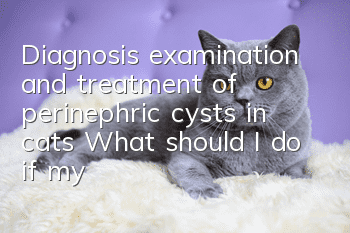Diagnosis, examination and treatment of perinephric cysts in cats (What should I do if my cat has perinephric cysts?)

Perinephric cyst in cats is a degenerative disease of the kidneys. A fibrous sac filled with fluid is formed around the kidneys. The nature of the fluid is usually leakage. Liquids are mostly low cell and low protein content liquids. The BUN and creatinine content in the liquid is similar to the blood content.
This disease is common in older (usually older than 8 years) and castrated male cats, but is rare in dogs. It is characterized by unilateral (60%) or bilateral (40%) perirenal cyst-like structures. Some data indicate that the difference in incidence rates among breeds may be related to the rich venous network structure under the renal capsule of cats. The cause of the disease is unknown, but some data indicate that it may be related to chronic renal parenchymal disease (renal fibrosis), renal tumors (renal adenocarcinoma), rupture of the kidney and proximal ureter (trauma), coagulation disease or renal puncture. The author's clinical diagnosis Several cases have a history of trauma, and it is unclear whether this is the cause of the disease.
1. Medical history and clinical symptoms:
The common medical history is progressive abdominal enlargement over weeks or months (Figure 1), which is very similar to a chronic disease (the author has seen several cases with a history of 2 years). An abdominal mass can be palpated during physical examination. In severe cases, it is often impossible to distinguish whether it is an enlarged kidney or another abdominal mass. Other clinical symptoms are mainly related to the degree of accompanying chronic renal insufficiency, such as polydipsia and polyuria, anorexia, chronic vomiting and weight loss.
2. Laboratory examination:
There are usually no obvious abnormal changes in laboratory tests. Unless chronic renal insufficiency exists, non-regenerative anemia may occur (Table 1), BUN and creatinine may increase (Table 2), and severe renal failure may cause metabolic acidosis, hyperphosphatemia, hypokalemia, etc. ( table 3). Routine urine examination may reveal decreased urine specific gravity and proteinuria.
3. Imaging examination:
Radioactive examination:
Abdominal radiographs showed enlarged kidneys and a large area of fluid density in the renal area (Figure 2-Figure 3). Excretory urography showed kidneys (enlarged/smalled), ureters, and bladder normal, The contrast agent did not enter the perinephric capsule:
Ultrasound examination:
Extraction of fluid accumulation under ultrasound guidance:
Perinephric cyst fluid laboratory analysis (Table 4):
The nature of cyst fluid is usually leakage fluid, which is mostly low-cell and low-protein content fluid. The content of BUN and creatinine in the fluid is similar to that of blood.
4. Differential diagnosis of related diseases:
Perinephric abscess, perinephric hematoma, renal enlargement, hydronephrosis, polycystic kidney, renal lymphoma
5. Treatment:
Surgical treatment:
Surgical drainage or cyst wall resection is usually performed to improve kidney function. Pseudocystotomy usually improves abdominal distension and abdominal organ displacement, however it does not halt the progression of kidney disease. In order to relieve abdominal distension and displacement of abdominal organs, temporary percutaneous drainage can be used to relieve the pressure, but the cyst usually fills up again in 1-2 weeks. Laparotomy is usually performed to remove the cyst with omental drainage, but mild ascites may occur in some cases. Nephrectomy can be performed if one kidney is functioning normally.
Medical treatment:
If the cyst becomes infected, consider antibiotic treatment. If renal dysfunction occurs, supportive therapy
6. Prognosis:
If the bilateral kidneys function normally, the prognosis is good; if the cat develops renal dysfunction after cyst removal, the prognosis is poor. Survival is related to the degree and progression of renal insufficiency.
- A cat will die if it urinates for a few days
- Should you deworm yourself or go to a pet store?
- Are cat teasers harmful to cats?
- What should I do if my cat suffers from chronic gingivitis?
- Cat's nails are cracked with a thin layer
- Cats go crazy after eating mutton
- What does cat moss on a cat’s chin look like?
- Can cats reproduce after abdominal transmission is cured?
- What exactly is the sterilization shot for female cats?
- Can I still eat unopened cat food if it has expired?



